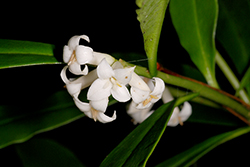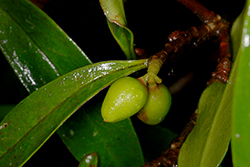e-Flora of Thailand
Volume 6 > Part 3 > Year 1997 > Page 244 > Thymelaeaceae > Daphne
2. Daphne sureil W.W.Sm. & Cavewfo-0000637911
Rec. Bot. Surv. India 6: 51, f. 2. 1913; Stapf, Bot. Mag. 156: pl. 9297. 1933; Hara, Photoalbum Eastern Himalaya f. 162. 1968; Brickell & Mathew, Daphne 65, 178. 1976.
Accepted Name : This is currently accepted.
Description : Shrub up to 3.5 m high; branches erect, young ones glabrous or hairy. Leaves narrowly elliptic to ovate-elliptic, acute to acuminate at both ends, (6–)9–14(–19) by 1.9–4.6 cm wide, light green, shining, thinly coriaceous, glabrous; petiole 5–10 mm long. Inflorescence terminal clusters, often also on side branches; bracts early deciduous; peduncle to 5 mm long, hirsute. Flowers 5–14, white or cream-coloured; pedicel 1–2 mm long. Calyx-tube 10–15 mm long, pubescent outside, fragrant; calyx-lobes narrowly ovate, acute to acuminate, 5–8 by 2–4 mm, ± pubescent. Stamens sub-sessile, anthers 1–2 mm long. Ovary ± 3 mm long, glabrous; style ± 2 mm long; disc slightly crenulated, 0.8–1.2 mm. Fruit 8–11 by 5 mm, orange-red.
Thailand : NORTHERN: Chiang Mai (Doi Phahom Pok, Doi Suthep,, Doi Inthanon).
Distribution : E Nepal, India (Sikkim – type, W Bengal, Assam, Meghalaya), Bangladesh.
Ecology : Scattered on mountain ridges in lower montane forests, 1,200–2,200 m alt.
Notes: Daphne sureil is very closely related to D. bholua Buch.-Ham. ex D.Don and D. shillong Banerji in the Eastern Himalayas as well as to D. papyracea Wall. ex Steud. emend. Smith & Cave in the Western Himalayas.
Daphne sureil is a thin shrub with erect branches, light green rather soft foliage and orange-red fruits while D. bholua is a very dense shrub with horizontal to drooping branches, leathery foliage and black fruits. Daphne papyracea has persistent bracts, often retained until young shoots appear; the flowers are not fragrant. Daphne shillong is very similar to D. sureil, only differing in the length of tubes and calyx-lobes.


